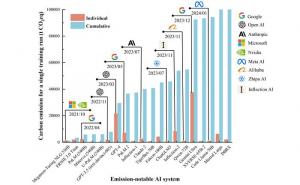Artificial Intelligence: Balancing Innovation and Environmental Impact
GA, UNITED STATES, November 4, 2024 /EINPresswire.com/ -- A new study highlights the rising environmental toll of artificial intelligence1, spotlighting the surge in energy consumption and carbon emissions driven by escalating computing demands. The research offers a comprehensive analysis of artificial intelligence’s (AI’s) carbon footprint, underscoring the urgent need for the tech sector to adopt sustainable practices to curb its substantial environmental impact.
As artificial intelligence (AI) technology progresses, the energy demands of training complex models have surged, raising widespread concerns about associated carbon emissions. This rapid growth is fueled by global demand across industries and academia, leading to exponential increases in compute power that carry significant environmental consequences. Given these challenges, in-depth research is essential to fully understand AI's carbon footprint and develop strategies for mitigating its environmental impact.
In a view (DOI: 10.1007/s11783-024-1918-y) by researchers from Zhejiang University and Nankai University, published in Frontiers of Environmental Science & Engineering on October 20, 2024, AI systems' carbon emissions were rigorously evaluated. The study analyzed emissions from 79 major AI systems between 2020 and 2024, underscoring the need for regulatory measures and standardized emissions caps. The findings estimate these AI systems could emit over 102 million tons of CO₂ annually, signaling the urgent need for policies to mitigate AI’s environmental footprint.
The research team quantified carbon emissions from 79 notable AI models released between 2020 and 2024, finding significant discrepancies in energy consumption. For example, Google’s Gemini Ultra model alone accounts for 36.7% of emissions among top AI systems, while GPT-4’s emissions rose twelvefold compared to its predecessor. The study reveals that operational demands in AI usage often eclipse training emissions, with annual emissions estimated at 960 times those from a single training run due to the global surge in AI service demand. Economically, the implications are vast: with a projected carbon price of $109 per ton, AI-related emissions could cost the industry over $10 billion annually. These findings underscore the need for standardized emissions metrics and caps, as AI’s carbon footprint is now comparable to the annual emissions of entire countries.
Dr. Meng Zhang, lead researcher from Zhejiang University, remarked, “The exponential growth in AI capabilities mirrors a concerning rise in its environmental impact. This study underscores the urgent need for the AI industry to adopt greener practices and sustainable standards. Our goal is to equip policymakers with the data needed to address AI’s carbon footprint through proactive regulations.” Dr. Zhang emphasized that balancing AI innovation with environmental responsibility is key to fostering a sustainable future.
The study's findings carry significant implications for environmental policy and AI development. As AI applications expand globally, managing carbon emissions becomes essential for minimizing environmental impacts and achieving climate goals. Emission caps could encourage the industry to adopt energy-efficient practices, prompting innovation in sustainable AI technology. Additionally, AI-related carbon metrics could assist policymakers in setting effective standards, ensuring that as AI advances, its environmental costs are controlled, paving the way for a sustainable AI future.
DOI
10.1007/s11783-024-1918-y
Original Source URL
https://doi.org/10.1007/s11783-024-1918-y2
Funding information
This work was financially supported by the Fundamental Research Funds for the Central Universities (No. 226-2024-00010), the National Key Research and Development Program of China (No. 2022YFC3203003) and the Key Project of Natural Science Foundation of Zhejiang Province (No. LZ23E080004).
Lucy Wang
BioDesign Research
email us here
1 https://doi.org/10.1007/s11783-024-1918-y
2 https://doi.org/10.1007/s11783-024-1918-y

